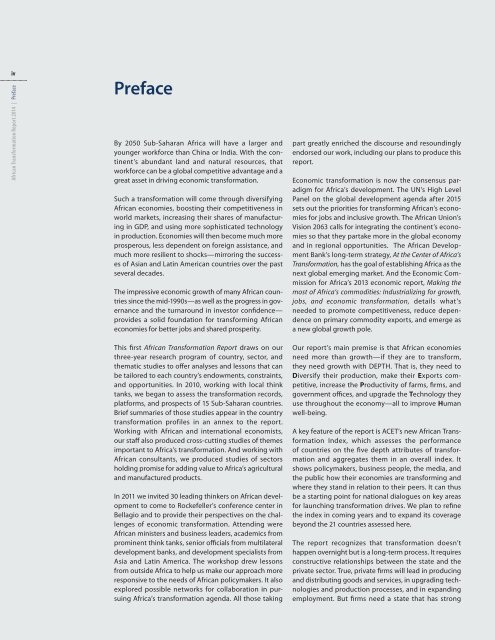2014-african-transformation-report
2014-african-transformation-report
2014-african-transformation-report
You also want an ePaper? Increase the reach of your titles
YUMPU automatically turns print PDFs into web optimized ePapers that Google loves.
ivAfrican Transformation Report <strong>2014</strong> | PrefacePrefaceBy 2050 Sub-Saharan Africa will have a larger andyounger workforce than China or India. With the continent’sabundant land and natural resources, thatworkforce can be a global competitive advantage and agreat asset in driving economic <strong>transformation</strong>.Such a <strong>transformation</strong> will come through diversifyingAfrican economies, boosting their competitiveness inworld markets, increasing their shares of manufacturingin GDP, and using more sophisticated technologyin production. Economies will then become much moreprosperous, less dependent on foreign assistance, andmuch more resilient to shocks—mirroring the successesof Asian and Latin American countries over the pastseveral decades.The impressive economic growth of many African countriessince the mid-1990s—as well as the progress in governanceand the turnaround in investor confidence—provides a solid foundation for transforming Africaneconomies for better jobs and shared prosperity.This first African Transformation Report draws on ourthree-year research program of country, sector, andthematic studies to offer analyses and lessons that canbe tailored to each country’s endowments, constraints,and opportunities. In 2010, working with local thinktanks, we began to assess the <strong>transformation</strong> records,platforms, and prospects of 15 Sub-Saharan countries.Brief summaries of those studies appear in the country<strong>transformation</strong> profiles in an annex to the <strong>report</strong>.Working with African and international economists,our staff also produced cross-cutting studies of themesimportant to Africa’s <strong>transformation</strong>. And working withAfrican consultants, we produced studies of sectorsholding promise for adding value to Africa’s agriculturaland manufactured products.In 2011 we invited 30 leading thinkers on African developmentto come to Rockefeller’s conference center inBellagio and to provide their perspectives on the challengesof economic <strong>transformation</strong>. Attending wereAfrican ministers and business leaders, academics fromprominent think tanks, senior officials from multilateraldevelopment banks, and development specialists fromAsia and Latin America. The workshop drew lessonsfrom outside Africa to help us make our approach moreresponsive to the needs of African policymakers. It alsoexplored possible networks for collaboration in pursuingAfrica’s <strong>transformation</strong> agenda. All those takingpart greatly enriched the discourse and resoundinglyendorsed our work, including our plans to produce this<strong>report</strong>.Economic <strong>transformation</strong> is now the consensus paradigmfor Africa’s development. The UN’s High LevelPanel on the global development agenda after 2015sets out the priorities for transforming African’s economiesfor jobs and inclusive growth. The African Union’sVision 2063 calls for integrating the continent’s economiesso that they partake more in the global economyand in regional opportunities. The African DevelopmentBank’s long-term strategy, At the Center of Africa’sTransformation, has the goal of establishing Africa as thenext global emerging market. And the Economic Commissionfor Africa’s 2013 economic <strong>report</strong>, Making themost of Africa’s commodities: Industrializing for growth,jobs, and economic <strong>transformation</strong>, details what’sneeded to promote competitiveness, reduce dependenceon primary commodity exports, and emerge asa new global growth pole.Our <strong>report</strong>’s main premise is that African economiesneed more than growth—if they are to transform,they need growth with DEPTH. That is, they need toDiversify their production, make their Exports competitive,increase the Productivity of farms, firms, andgovernment offices, and upgrade the Technology theyuse throughout the economy—all to improve Humanwell-being.A key feature of the <strong>report</strong> is ACET’s new African TransformationIndex, which assesses the performanceof countries on the five depth attributes of <strong>transformation</strong>and aggregates them in an overall index. Itshows policymakers, business people, the media, andthe public how their economies are transforming andwhere they stand in relation to their peers. It can thusbe a starting point for national dialogues on key areasfor launching <strong>transformation</strong> drives. We plan to refinethe index in coming years and to expand its coveragebeyond the 21 countries assessed here.The <strong>report</strong> recognizes that <strong>transformation</strong> doesn’thappen overnight but is a long-term process. It requiresconstructive relationships between the state and theprivate sector. True, private firms will lead in producingand distributing goods and services, in upgrading technologiesand production processes, and in expandingemployment. But firms need a state that has strong


